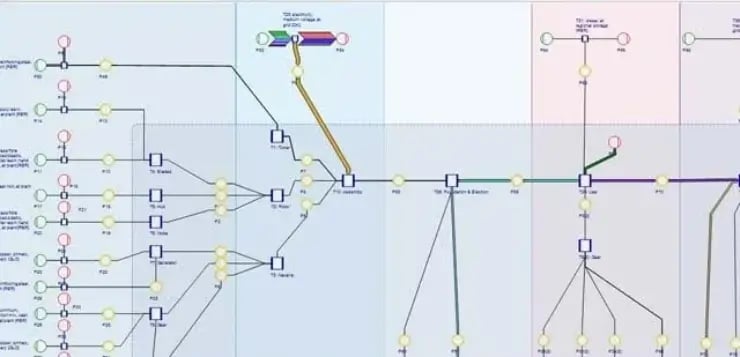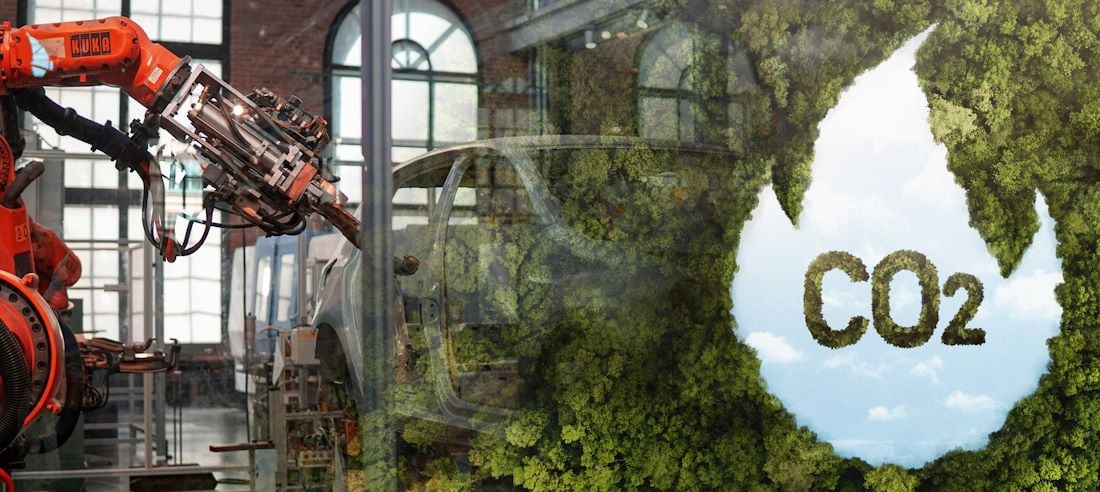Environmental effects are extremely complex, that’s why they’re impossible to measure, so let’s not bother about them too much and keep producing and consuming the way we have over the past 100 years! Why should we change that anyway? Isn’t the GDP still growing after all? Don’t we lead a comfortable good life?
Even though this approach may seem strikingly ignorant to some of you, it appears to be common sense among mainstream business people and a general majority in most societies. And, yes, everything is complex indeed: the supply chains of global retailers, the climate, the just-in-time production schemes… Impossible to understand intuitively, all of them. But just relax! In this article, I’ll show you a concrete method to calculate environmental effects. It is definitely possible. Concerned scientists and environmentalists started to lay the foundations for this method back in the 1960s, and since then it has made big steps toward practical significance and usability. It is the very method we call life cycle assessment. Nowadays, sustainability practitioners and scientific work groups around the globe apply LCA and the method is recognized and well-tried. Still, our era of globalization and business complexity gives concerned customers one brain teaser after the other. Even if we want to support the right thing, we just don’t know how. Now, the good news is that our era arrives hand in hand with sophisticated information technology and, believe it or not, it is this very IT that can save the planet. You must be aware of the fact that normal people can have hundreds or even thousands of friends now; information technology is even capable of telling all of them simultaneously that you’re having a latte at your favorite coffee chain! But seriously, there is some really good news related to helpful software, and this is what I want to share with you today. With the help of computer technology (well-designed computer technology, of course), you can break down any supply chain into comprehensible pieces. You can fully understand any production process, no matter how many materials are involved, no matter how many sub-processes there are, no matter how diverse the environmental interaction. Material flow analysis is the keyword.
Sustainable, Efficient, Well-Perceived: Good Business is Responsible
It has to be said that, without this understanding, getting an idea of a business’s environmental interactions is not possible. You need to want to understand what really happens in your factory, you need motivation to make your retailing structures transparent. Indeed, the lack of this can totally spoil a meaningful assessment – maybe that’s why environmental assessment has such a complicated image. But let’s assume you want to get a grip on the environmental costs of your product, be it because you feel responsible for the state of the earth that you will hand to future generations, or simply because it facilitates improvements in the process chains to save you good money. Not forgetting the public relation benefits that responsible companies enjoy, too, a notoriously big driver for environmentally sage business models. Well, not only does crisis vulnerability get reduced, but better environmental efficiency, in terms of material and energy use, does also result in better cost efficiency.
Practicality Oriented, But Still Precise: Life Cycle Assessment
Whatever the motivation, the tool of choice is called life cycle assessment. Of course, every method has its pros and cons. No technological solution will ever reflect every single aspect of the ecosystem services we inevitably depend on. But in my humble opinion, there is no other method that so neatly combines practical applicability with scientific precision. Life cycle assessment (LCA), sheds light on all phases of a product’s life cycle. Yeah, products don’t live in the biological sense, that’s certainly true, but products go through very different stages and collectively, a “cycle of life” is a good way to picture it. The somewhat normative nature of the term connects to ecology, since it focuses on one ultimate theoretic goal, a closed loop cycle with no polluting leftovers.
All Stages of “Product Life”
A full cradle-to-grave LCA begins with the extraction of all necessary raw materials to make a product, then analyzes conversion and transport of the materials, all production and assembly stages, and the related use of energy and materials for transport in between. Moreover, it looks at the different retail steps to the final point of sale. But that’s not all. For many products, most emissions are generated during the use phase, so an LCA would also look at what happens when the product has reached the hands of the customer. Disposal is also of essential importance. How much of the product’s content can be reused, how much recycled, how much energy does that cost, how much water will be polluted after all the time the wasted product sits in the landfill? All these steps are basically modeling reality, simulating the material flows and processes involved. Now just as is every production, every model is unique. It is up to you to set system boundaries. The full cradle-to-grave approach described above is just one example. Depending on what you want to learn or what comparison you want to make, you can also follow a cradle-to-gate approach, for instance, where only the first stages of the product life cycle are regarded, as in raw material extraction and production. Gate refers to the factory gate. Gate-to-gate approaches could be of interest if you compared different forms of distribution and transport in a business-to-business scope. Whatever the system boundaries may be, for all the steps involved, LCAs provide a method of analysis that results in a number of figures.
Complex Model, Easy Result: The Impact Category
These figures could be called “normalized environmental effects”. They show the output of all flows relevant to the environment, be it greenhouse gases, toxic pollutants or water consumption, to give a few examples. These results are collected in various impact categories. Impact categories are forms of environmental impacts. Gases emitted throughout the life cycle of a product, for instance, could be relevant for three different impact categories: global warming potential (commonly known greenhouse gases like carbon dioxide or methane, but also CFCs and HCFCs), stratospheric ozone depletion (CFCs or HCFCs) and acidification (carbon dioxide and sulfur oxides). Each impact category affects the environment on a certain scale – whereas global warming naturally refers to a global scale (who would have thought that!?), acid rains occur regionally or locally. Other impact categories are relevant on a local scale only, like photochemical smog (some hydrocarbons) or aquatic toxicity (certain chemicals). Land use, however, has an impact on all scales. All that is very complex. Was the introductory phrase right after all? Does the environment really paralyze us with all its complexity? Well, this is where the beauty of LCA comes into play: it unites all emissions, all product stages and all scales into the most important impact categories, mostly about a dozen of them. That gives you a good overview without losing track of the actual facts.
Which LCA Tool?
Wow! Now, I want to conduct a life cycle assessment! What do I have to do? Oh, well, you have quite a few options. From the basic open source program for students to the sophisticated software solution for research and industry, there are numerous options available. Your choice basically depends on two dimensions: first, how complex is the product or the service you want to analyze, and second, are all necessary data available? Er, yes, your available resources may also have a few words to say (I’m actually referring to your financial resources here, for once…). Generally, the level of complexity exceeds what you might have guessed it to be in the first place, especially for most consumer products, and in 99 out of 100 cases data is not fully available for all life cycle stages. So you better choose a solution that has a good database included (ecoinvent, for instance). You may, for instance, know how much electric energy your air compressor uses, but you may not exactly know how this electricity was generated. This is where databases come into play: they provide average electricity mixes for most countries in the world.
One software I want to highlight in particular here is Umberto. Not only because Umberto is a great product and its creators, who have been LCA software engineers for more than 20 years, unconditionally sponsor this blog, but also because it is highly versatile and received a major update last week, too.
What does LCA software look like?
 Here’s a screenshot of a project analyzed with Umberto NXT LCA. It shows the processes involved in the life cycle of a wind turbine. The mass flows are visualized by arrow thickness (Sankey diagram view). Each phase has a different color: dark blue for raw material extraction, blue for manufacturing, light blue for distribution and setup, pink for use (in this case electricity generation), and violet/green for disassembly, disposal and recycling.
Here’s a screenshot of a project analyzed with Umberto NXT LCA. It shows the processes involved in the life cycle of a wind turbine. The mass flows are visualized by arrow thickness (Sankey diagram view). Each phase has a different color: dark blue for raw material extraction, blue for manufacturing, light blue for distribution and setup, pink for use (in this case electricity generation), and violet/green for disassembly, disposal and recycling.
 Once you or your consultant have finished the modeling, Umberto generates these little bars at the bottom for you (image to the right). This particular view shows you, in relation to all emissions generated, how much a certain phase has contributed to each impact category. As I said earlier, both LCA in general, and Umberto in particular, are very versatile instruments. For the wind turbine LCA seen on this screenshot, especially relevant impact categories have been chosen, e.g., ionizing radiation and metal depletion. The former being a controversial issue often referred to as electromagnetic radiation, the latter, embodied emissions, being less known, but not least important.
Once you or your consultant have finished the modeling, Umberto generates these little bars at the bottom for you (image to the right). This particular view shows you, in relation to all emissions generated, how much a certain phase has contributed to each impact category. As I said earlier, both LCA in general, and Umberto in particular, are very versatile instruments. For the wind turbine LCA seen on this screenshot, especially relevant impact categories have been chosen, e.g., ionizing radiation and metal depletion. The former being a controversial issue often referred to as electromagnetic radiation, the latter, embodied emissions, being less known, but not least important.
Links
- Web Demo Dates for Umberto NXT LCA: www.umberto.de/en/webdemos/lca-web-demo
- Feature List and Trial Download of Umberto NXT LCA (after registration): www.umberto.de/en/versions/umberto-nxt-lca/
- To Recycle or Not to Recycle – PVC Cable Waste is the Question (knowtheflow 07/2012): Comparative LCA made with Umberto
-
Burn or Bury? Analyzing Waste Management Options in Detail (knowtheflow 11/2012): Comparative LCA of three waste management options in Portugal





